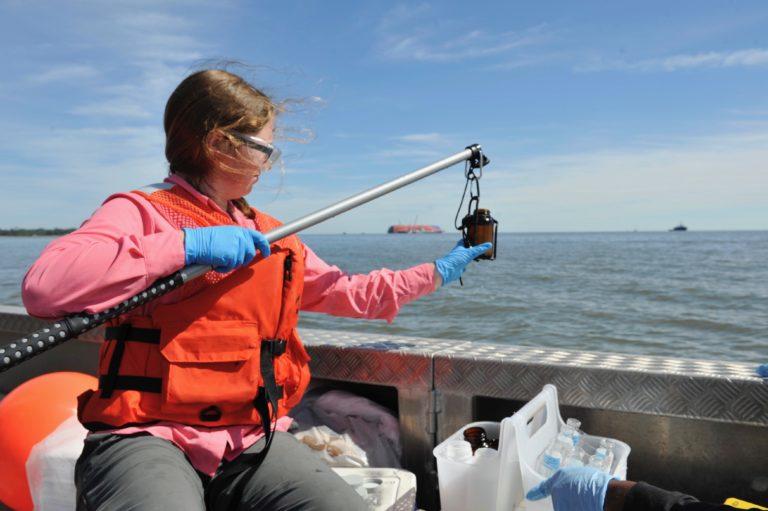Section Branding
Header Content
Scientists Race To Track Oil From Capsized Ship
Primary Content
The capsized cargo ship Golden Ray is still trapped in St. Simons Sound. And, while trapped, it has repeatedly leaked oil. Teams of scientists are working to trace the oil and limit its impact on the delicate marsh ecosystem. But there could be disagreement about just how far the oil is spreading.Scientists are working to trace the oil from the capsized ship Golden Ray, but there could be disagreement about how far it's spread.
Before dawn on an October morning at the Champney River boat ramp, about half an hour north of where the Golden Ray sits looming over the St. Simon’s pier, Fletcher Sams could see a sheen on the water by the beam of his cellphone’s flashlight.
“It’s hard to see but you see, like, I’m not talking about the brown color I’m talking about the film on the top,” explained Sams, the executive director of Altamaha Riverkeeper.
Sams used a stick to break up the oily film on the top of the water. It re-formed the second he pulled out the stick, a sign that it’s oil and not something natural
“And so poking it with a stick is the scientific method,” he joked.
Of course, the actual scientific method is a lot more sophisticated. A researcher from UGA pulled on waders to stride into the dark water and collect a sample. Others came from places all over the region with oil in the water, on the ground and coating marsh grass.
The samples went back to Athens for testing in the lab.
“Every hydrocarbon is distinct, and it has a fingerprint,” explained oceanographer and UGA professor Samantha Joye. She was one of the lead researchers on the Deepwater Horizon oil spill in the Gulf of Mexico. She’s recognized as international expert.
“We extract the hydrocarbons out of those samples and then we run them on this really fancy instrument,” she said. “And we can determine what’s in there.”
They can not only tell what kind of oil it is, they can specifically match it to other samples.
Joye is not the only one doing this kind of fingerprinting. So is Unified Command, the joint response effort of the state, the Coast Guard, and the responsible party, Gallagher Marine.
Doug Haymans with the state Department of Natural Resources said they want to make sure the oil they find definitely came from the ship.
“There are there are things that have been picked up in those water quality samples that we have seen in this estuary prior to this incident,” he said. “And so that's where the real work is going to be, is determining whether or not anything that we're seeing is because of the incident.”
The only way for either Joye or Haymans to be sure where the oil came from is to compare it to a sample from the ship.
Unified Command has that sample. Joye does not. Haymans said releasing the sample will be handled “on a case by case basis based on request.” Joye has requested it.
What troubles Joye is that, while she is willing to share what she is learning about the oil’s spread, Unified Command has so far not shared with her as much as she’d like. She said that could put Georgia communities on the back foot.
“Imagine a year, a year and a half from now when there’s litigation and a settlement,” Joye said. “What ecosystems along coastal Georgia were damaged from this spill? We have to be able to answer that question in a robust way that protects the people and the ecosystems of the state of Georgia.”
Unified Command is collecting samples weekly from 22 sites in the surrounding waterways and coastlines. Joye on the other hand is going wherever there’s oil in water. If she could compare her samples to the fuel and oil from the Golden Ray, it might paint a more far reaching picture of the spill.
“We hope that when this is all over, the work that the University of Georgia is doing and the work that Unified Command is doing will help tell a complete story,” Haymans said.
But Joye said “when this is all over” isn’t soon enough when there’s oil spreading through the Marshes of Glynn County, and maybe beyond, right now.


